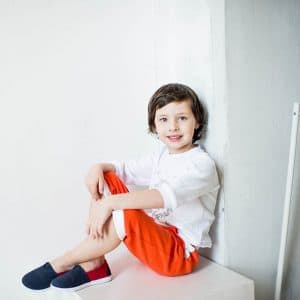The Pediatric Eye Disease Investigator Group (PEDIG) research provided evidence-based studies on treatment for children with lazy eye.
PEDIG research on the effectiveness of lazy eye treatments has enabled eye doctors to recommend appropriate treatment with minimal discomfort and maximum compliance.
Through PEDIG research, new treatment methods have been proven effective, enabling children and parents to follow through on their prescribed treatment regimens— including eye patching, atropine drops, and corrective eyeglasses.
Patching
PEDIG research has disproven the long held belief that full-time daily patching is required for treatment of lazy eye. Prior to PEDIG research, child and parent compliance to full-time patching was poor, with many complaints about the social stigmas and discomfort associated with this method.
According to PEDIG research:
Eye patching for moderate lazy eye, for two hours per day, with one hour of near vision exercises, is just as effective as patching for six hours per day or even full time patching!
The research revealed that 62 percent of patients that patched for two hours per day showed improved visual acuity within about four months of treatment.
Similarly, in cases of severe amblyopia, six hours of patching per day has been shown to be as effective as full-time patching.
Eye doctors are eager to publicize these findings as they believe that patient compliance will increase significantly— leading to better treatment outcomes.
According to the research, greater improvement is seen when patching treatment begins before the child turns five, as compared to children that begin patching between ages 7 to 17. It is therefore recommended to schedule an eye exam as soon as symptoms are noticed.
SEE RELATED: Lazy Eyes Need Binocular Vision Therapy
Corrective Eyeglasses
According to PEDIG research, 77 percent of children with refractive amblyopia showed improved vision acuity within fifteen weeks of wearing corrective eyeglasses.
This research indicates that passive treatment using only eyeglasses, can improve visual acuity.
However, the eyeglasses alone do not treat the underlying problem— a treatment program of vision therapy is usually prescribed to retrain the eye-brain connections of the lazy eye.
Atropine
Atropine drops are applied to the non-affected eye (the good eye) in order to blur vision, and force the lazy eye to become stronger. According to PEDIG, the drops have been proven just as effective as patching for moderate lazy eye.
Atropine drops can cause physical discomfort such as stinging and blurry vision. For this reason, daily administration, as was recommended prior to PEDIG research, yielded poor patient compliance.
The good news is, according to PEDIG trials, in moderate to severe amblyopia:
Daily use of atropine drops are not necessary for noticeable improvement of vision— using atropine drops only on weekends shows equal amounts of improvement!
This finding will likely result in increased compliance and patient satisfaction with lazy eye treatment.
Recurrence
According to research, around 20 percent of children will encounter recurrence of a lazy eye after completion of treatment— it is therefore important for eye doctors to monitor progress and stability of vision, regularly.
Recurrence of lazy eye is more likely to occur when discontinuation of treatment is not executed properly. All lazy eye treatment methods must be tapered down slowly, as directed by your eye doctor, to prevent regression.
Ineffective Treatments
PEDIG trials have concluded that certain treatment modalities are not effective for lazy eye treatment. Levodopa, has been prescribed for residual amblyopia for years. However, the most recent research has shown that the medication is actually not effective for lazy eye treatment.
Moreover, PEDIG research has shown that wearing a plano lens in addition to administering atropine drops has not proven to be effective.
LEARN MORE: Vision Therapy for Lazy Eye
Contact an eye doctor near you who specializes in treating lazy eye.
As a result of the latest research on lazy eye, the PEDIG team has revolutionized the way eye doctors recommend lazy eye treatment, and has helped to increase optimal results for many children.
Other references for lazy eye research:
- Baroncelli L, Bonaccorsi J, Milanese M, Bonifacino T, Giribaldi F, Manno I, Cenni MC, Berardi N, Bonanno G, Maffei L, Sale A., Enriched experience and recovery from amblyopia in adult rats: impact of motor, social and sensory components. Neuropharmacology. 2012 Jun;62(7):2388-97.
- Kulp MT, Foster NC, Holmes JM, Kraker RT, Melia BM, Repka MX, Tien DR; Pediatric Eye Disease Investigator Group, Effect of Ocular Alignment on Emmetropization in Children <10 Years With Amblyopia”. Am J Ophthalmol. 2012 May 23.
- Bandrakalli P, Ganekal S, Jhanji V, Liang YB, Dorairaj S.J Pediatr Ophthalmol Strabismus. Prevalence and Causes of Monocular Childhood Blindness in a Rural Population in Southern India 2012 May 22:1-5.
- Levi DM, Prentice Award Lecture 2011: Removing the Brakes on Plasticity in the Amblyopic Brain, Optom Vis Sci. 2012 May 10.
- Alotaibi AG, Fawazi SM, Alenazy BR, Abu-Amero KK. Outcomes of 3 hours part-time occlusion treatment combined with near activities among children with unilateral amblyopia Saudi Med J. 2012 Apr;33(4):395-8.
- Tognini P, Manno I, Bonaccorsi J, Cenni MC, Sale A, Maffei L., Laboratory of Neurobiology, Scuola Normale Superiore, Pisa, Italy. Environmental enrichment promotes plasticity and visual acuity recovery in adult monocular amblyopic rats PLoS One. 2012;7(4):e34815. Epub 2012 Apr 11.
- Knox PJ, Simmers AJ, Gray LS, Cleary M., An exploratory study: prolonged periods of binocular stimulation can provide an effective treatment for childhood amblyopia Invest Ophthalmol Vis Sci. 2012 Feb 21;53(2):817-24.
- Awadein A, Fakhry MA. Changes in binocular function in anisometropic nonstrabismic children with optical correction and occlusion therapy. J AAPOS. 2011 Dec;15(6):545-50.
- Baroncelli L, Maffei L, Sale A. New perspectives in amblyopia therapy on adults: a critical role for the excitatory/inhibitory balance. Front Cell Neurosci. 2011;5:25. Epub 2011 Nov 24.
- Astle AT, McGraw PV, Webb BS. Strabismus. 2011 Sep;19(3):99-109.
- Li RW, Ngo C, Nguyen J, Levi DM. Video-game play induces plasticity in the visual system of adults with amblyopia PLoS Biol. 2011 Aug;9(8):e1001135. Epub 2011 Aug 30.
- El-Shamayleh Y, Kiorpes L, Kohn A, Movshon JA. Neurosci. Visual motion processing by neurons in area MT of macaque monkeys with experimental amblyopia. 2010 Sep 8;30(36):12198-209.
- Scheiman M, Mitchell GL, Cotter S, et al. the Convergence Insufficiency Treatment Trial (CITT) Study Group. A randomized clinical trial of treatments for convergence insufficiency in children. Archives of Ophthalmology. 2005;123:14-24.
- Birnbaum MH, Koslowe K, Sanet R. . Am J Optom Phys Optometry 1977; 54:269-275.
- Cotter S. Conventional therapy for amblyopia. Problems in Optometry, RP Rutstein (ed), 3(2): 312, 1991.
- Garcia RP. Efficacy of vision therapy in amblyopia: a literature review. Am J Optom Phys Opt 1987; 64:393-404.
- Wick B, Wingard M, Cotter S, Scheiman M. Anisometropic amblyopia: is the patient ever too old to treat?, Optom Vis Sci. 1992 Nov;69(11):866-78.









